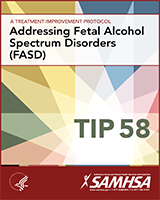From: Appendix E, Comparison of Current FASD Diagnostic Systems

NCBI Bookshelf. A service of the National Library of Medicine, National Institutes of Health.
| 4-Digit Code (2004) | CDC (2004) | Canadian (2005) | Revised IOM (2005) | IOM (1996) | |
|---|---|---|---|---|---|
| Growth | Prenatal and/or postnatal height or weight < 10th percentile (Growth Ranks 2-4) | Prenatal and/or postnatal height or weight < 10th percentile | At least 1 of the following:
| Prenatal and/or postnatal height or weight < 10th percentile | At least 1 of the following:
|
| Face | All 3 of the following at any age:
| All 3 of the following:
| All 3 of the following at any age:
| 2 or more of the following:
| Characteristic pattern that includes features such as short PFL, flat upper lip, flattened philtrum, and flat midface. |
| CNS | At least 1 of the following:
| At least 1 of the following:
| At least 3 of the following Structure/Neurological/Functional domains with impairmentc:
| At least 1 of the following:
| At least 1 of the following:
|
| Alcohol | Confirmed or Unknown (Alcohol Ranks 2, 3 or 4) | Confirmed or Unknown | Confirmed or Unknown | Confirmed-excessive or Unknown | Confirmed-excessive or Unknown |
4-Digit Code: Domains may include, but are not limited to: executive function, memory, cognition, social/adaptive skills, academic achievement, language, motor, attention, or activity level.
CDC: Performance substantially below that expected for an individual's age, schooling, or circumstances, as evidenced by: 1) Global cognitive or intellectual deficits representing multiple domains of deficit (or significant developmental delay in younger children) with performance below the 3rd percentile (2 standard deviations below the mean for standardized testing) or 2) Functional deficits below the 16th percentile (1 standard deviation below the mean for standardized testing) in at least three of the following domains: a) cognitive or developmental deficits or discrepancies b) executive functioning deficits c) motor functioning delays d) problems with attention or hyperactivity e) social skills f) other, such as sensory problems, pragmatic language problems, memory deficits, etc.
Canadian: Impairment indicates scores ≥ 2 SDs below the mean, discrepancies of 1.5-2 SDs among subtests, or ≥ 1 SD discrepancy between subdomains.
From: Appendix E, Comparison of Current FASD Diagnostic Systems

NCBI Bookshelf. A service of the National Library of Medicine, National Institutes of Health.